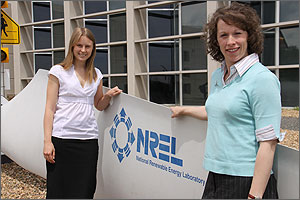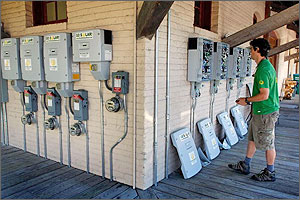NREL Energy Analysts Dig into Feed-In Tariffs
|
Feed-in tariffs (FiTs) are the world's most widely used policy to drive renewable energy development. They have helped transform cloudy Germany into the world leader of installed solar power and photovoltaic manufacturing. Now FITs are stimulating green energy investment in North America, too. Locations as disparate as the city of Gainesville, FL, the province of Ontario, Canada, and the state of Washington recently have adopted measures establishing guaranteed long-term prices for clean electricity. A dozen more states and many more communities are considering similar energy policy proposals. NREL energy analysts are digging into these complex policies in a series of technical reports designed to inform government policy makers, clean energy investors, utilities and other stakeholders. Feed-in tariffs guarantee long-term payments at pre-established rates for the electricity generated from renewable sources. The production-based payments are often higher than market rates, but are on the verge of becoming competitive in specific locations for certain technologies such as wind power. While utilities are obligated to buy the power, the long-term payments help encourage renewable energy development by reducing risks for investors. Any added costs are typically passed along to ratepayers and, for technologies like wind and landfill gas, may provide a hedge against electricity price volatility and large price spikes over the long-term. According to the NREL studies, experience around the world suggests that FITs can effectively expand renewable energy deployment and remove barriers to renewable energy development, while creating jobs and helping meet renewable energy standards. |
Key Factors to FIT Success NREL analysts have identified several key factors in a successful FIT policy: * Stability. Energy projects require several years to develop, so FITs have to be in place five years or longer to encourage certainty with investors and manufacturers. * Long-term contracts. Contracts in the range of 15-20 years allow investors time to recover their costs. * Adequate energy prices. FITs must cover project costs, plus a reasonable return to create stability, attract investors, lower risk and keep financing relatively simple. * Annually decreasing payments. As innovation and growth reduce technology costs, tariffs should be lowered according to a transparent and incremental plan. This encourages rapid deployment and increases competition among manufacturers. * Differentiate payments according to technology type, project size and resource quality. * Incorporate FIT into the electricity rate base. Tying FIT payments to ratepayers distributes costs and provides certainty that investors will get paid. * Reduce bureaucracy. Streamlining approvals reduces barriers and costs. Streamlining procedures especially helps small projects and encourages broader participation. |
States — or even local communities — may be tempted to copy the successful German model word for word. But, NREL analysts say that FITs are most effective when the policy design is adapted to local context.
"Every jurisdiction has unique characteristics that will influence the details of the FIT design and affect its success — these local differences are critical to consider," said Karlynn Cory (pictured below), co-author of State Clean Energy Policies Analysis (SCEPA) Project: An Analysis of Renewable Energy Feed-in Tariffs in the United States (PDF 1.1 MB).
The NREL reports examine a wide range of FIT programs. For example, Gainesville's tariff is limited to photovoltaic projects with a total city-wide cap of 4 megawatts (MW). Under Washington state's FIT policy, solar PV, solar thermal, wind, and anaerobic digesters are offered a payment that differs by technology and that increases if system components are manufactured in-state.
This spring, the Canadian province of Ontario revised its three-year
old program to include a 20-year fixed price of as much as US $0.69 for
every kilowatt-hour of solar power generated. In response, SunEdison,
First Solar, Everbrite Solar and Nanosolar are developing both solar
energy farms and manufacturing facilities near Ottawa, Kingston and other
cities. (Below, left: NREL energy analysts Claire Kreycik, left, and
Karlynn Cory have examined feed-in tariffs in North America and Europe.
Credit: Joe Verrengia)
 Timely
Topic
Timely
Topic
With so many tariff options, Cory said it is timely for the Laboratory's Strategic Energy Analysis Center to tackle the topic.
"Understanding the policy design options allows decision makers to formulate more effective policies for their specific circumstances," Cory said. "This was a real opportunity for NREL to evaluate the key lessons learned in Europe and translate them to the U.S. context."
The second NREL study of FITs suggests that the policy can work effectively with renewable portfolio standards (RPS). States use RPS policies to set long-term requirements on how much renewable energy must be developed to meet consumer demand, boost clean energy development and reduce their reliance on fossil fuels.
Cory co-authored that report, Feed-in Tariff Policy: Design, Implementation, and RPS Policy Interactions (PDF 446 KB), with NREL analyst Claire Kreycik (pictured above) and Toby Couture, now of E3 Analytics.

Kreycik recently briefed New York state policymakers on how FITs can drive renewable energy deployment and job creation as they prepare to vote on an FIT proposal.
RPS mandates have been adopted in 29 states and Congress is considering a national standard. However, not all of these policies are designed to address investors' needs for revenue certainty. That's where FIT programs can be complementary. (Image: A technician installs meters at a new solar energy project in Gainesville, Fla. The city has adopted a local feed-in tariff to support the development of up to 4 MW of solar energy. Credit: Joe Raedle/Getty Images)
"RPS policies tend to set the requirement and let the market figure out how to get there," Cory said. "FIT policies can help utilities meet their RPS target. It doesn't have to be an either-or choice."
A third NREL report will focus on best practices for feed-in tariff policies. It will be completed later this year.
Joseph B. Verrengia writes for the U.S. Department of Energy's National Renewable Energy Laboratory (NREL) in Golden, Colorado.
This article originally appeared as a National Renewable Energy Laboratory feature article and was reprinted with permission.
 To subscribe or visit go to:
http://www.renewableenergyaccess.com
To subscribe or visit go to:
http://www.renewableenergyaccess.com